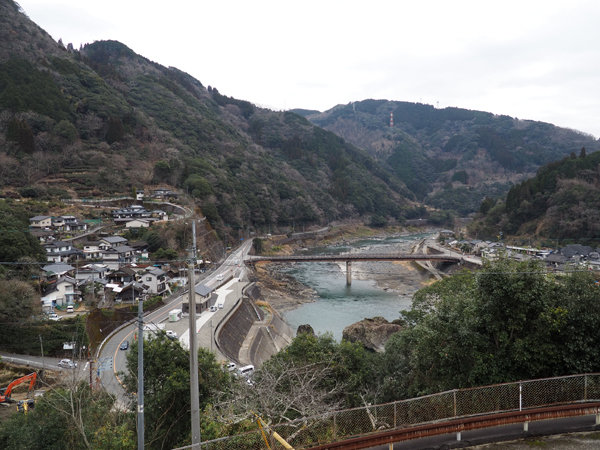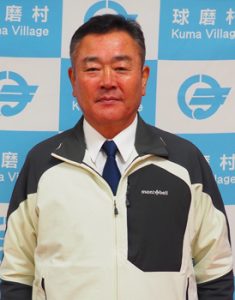Series ”Visiting the village” in search of the key to regional revitalization19 Kuma Village, Kumamoto Prefecture


松谷浩一村長(Mayor Matsutani)
Kuma Village, Kumamoto Prefecture, suffered severe damage from the “July 2020 Heavy Rains”. The impact is still ongoing, with agriculture, the village’s core industry, taking a major hit and accelerating the population decline. In the midst of this, Kuma Village is trying to find a way forward through tourism and game meat. (Kitajima Kei)
Kuma Village is a village in Kuma District in the southern part of Kumamoto Prefecture. Kuma District is made up of five villages connected together in a cluster around Hitoyoshi City, and Kuma Village is one of them.
The village had a population of about 3,500, but suffered severe damage from the “July 2020 Heavy Rains” (hereinafter referred to as the “2020 Heavy Rains”) in 2020, and as a result, the population has dropped sharply. Its current population is down to about 2,600. Village Mayor Matsutani Koichi said, “Kuma Village’s population had been declining even before the torrential rain disaster. The population decline is not necessarily due to the disaster, but it is true that the disaster was a strong blow, and we expect the population to continue to decline for a while.”
The heavy rains of 2020, which occurred during the COVID-19 pandemic, had such an enormous impact that it put the survival of Kuma Village in jeopardy.
Heavy rains of over 30 mm per hour fell from late at night to the early hours of July 3, causing the Kuma River to flood. Most of the first floors of buildings along the Kuma River were flooded.
“Until the day before the rain fell, we had no idea that the Kuma River would flood, so we had little sense of crisis. A heavy rain warning was issued, so we opened evacuation shelters in the evening and called on villagers to evacuate, but most villagers thought there was no need to evacuate based on past experience, so they were not very worried,” said Mayor Matsutani, looking back on that time.
It is said that heavy rains at the end of the rainy season often fall from late at night to the early hours of the morning. The heavy rains of 2020 also started falling late at night, and flooding had already occurred by the early hours of the morning. Many villagers were asleep, and when they woke up, they found it impossible to escape.
Kuma Village’s core industry is agriculture and forestry, but the heavy rains caused devastating damage. Kuma Village never had much farmland, but the Watari district upstream of the Kuma River was prime farmland, producing rice and pears. It was hit hard, and crops could no longer be grown there. They have now given up on using it as farmland and are trying to turn it into a flood control reservoir.
“We are preparing farmland in other locations, but since there are many elderly farmers, more and more are taking this opportunity to quit. I think agriculture in Kuma Village will become even more difficult in the future,” says Mayor Matsutani.
Not only farmland, but also agricultural facilities such as waterways were destroyed. Some people are quitting farming because they cannot farm without water.
The waterways are in the mountains, and some were built by hand by people in the past. Construction companies are reluctant to take on the restoration work of these waterways. Currently, various restoration works are ongoing, and the restoration of agricultural services is lagging behind.
The transportation network was also affected, and the JR Hisatsu Line remains closed. Commuting to work or school from Kuma Village has become inconvenient, and an increasing number of villagers are moving to Hitoyoshi City and Yatsushiro City.
The disaster has dealt a major blow to Kuma Village’s core industries, and the disruption of the transportation network has accelerated the decline in Kuma Village’s population.
As a way to get out of this predicament, the village is turning its focus to tourism promotion, centered on the forest.
“88% of Kuma Village is forest. We also have Kyusendo, one of the largest limestone caves in Kyushu. We would like to use this to promote forestry and tourism,” says Mayor Matsutani.
In terms of promoting industry, game meat is also on the horizon. Kuma Village has a large deer population, and 1,800 deer were captured last year. They will be put to good use through game meat.
“We will build a large processing plant for gibier next year, and also an incinerator. Currently, only about 400 of the 1,800 animals we have captured are used as gibier. We would like to increase that to about 1,000,” said Mayor Matsutani.

球磨村の風景。いまも各地で復旧工事が進められている(A view of Kumamura village. Restoration work is still underway in various areas)
Based on the lessons learned from the heavy rains of 2020, we will also focus on disaster prevention measures.
Mayor Matsutani said, “Of course, disaster DX is important, but I also place importance on how much the villagers have an awareness of evacuation.” At present, we are promoting voluntary disaster prevention organizations and placing emphasis on creating a framework for mutual assistance. We will also improve the disaster prevention radio. The disaster prevention radio was originally equipped with outdoor speakers and indoor receivers, but the sound of the disaster prevention radio could not reach the villagers due to the heavy rain.
In light of the fact that heavy rain that could not hear the disaster prevention radio caused the disaster, we will place importance on evacuating while it is still light, while you can move, and while you can hear the disaster prevention radio, especially at the end of the rainy season, and will take measures to achieve this.
Regarding DX, we plan to formulate the “Kuma Village DX Plan” within this fiscal year. First of all, they will tackle digital transformation of administrative services.
“Kuma Village has 78 settlements scattered over a large area. That’s why we want to use digital transformation to make it easier for villagers to complete procedures without coming to the town hall,” said Mayor Matsutani. However, he added, “I still have doubts about whether digital transformation will really make town hall operations more efficient and whether we can get the job done with fewer staff. As I mentioned earlier, Kuma Village has settlements scattered over a large area, so we will inevitably need a corresponding number of staff.”
※Translating Japanese articles into English with AI
